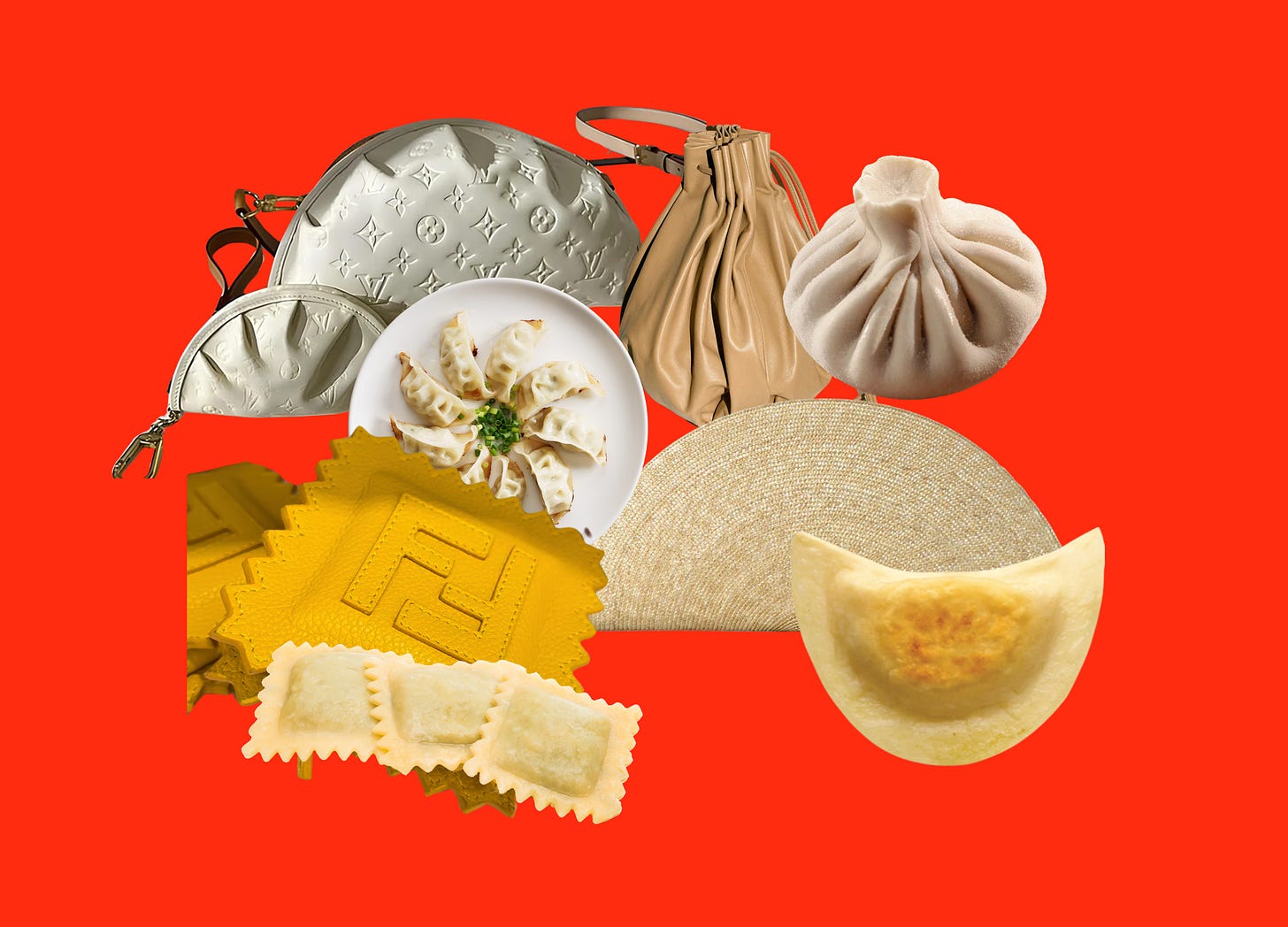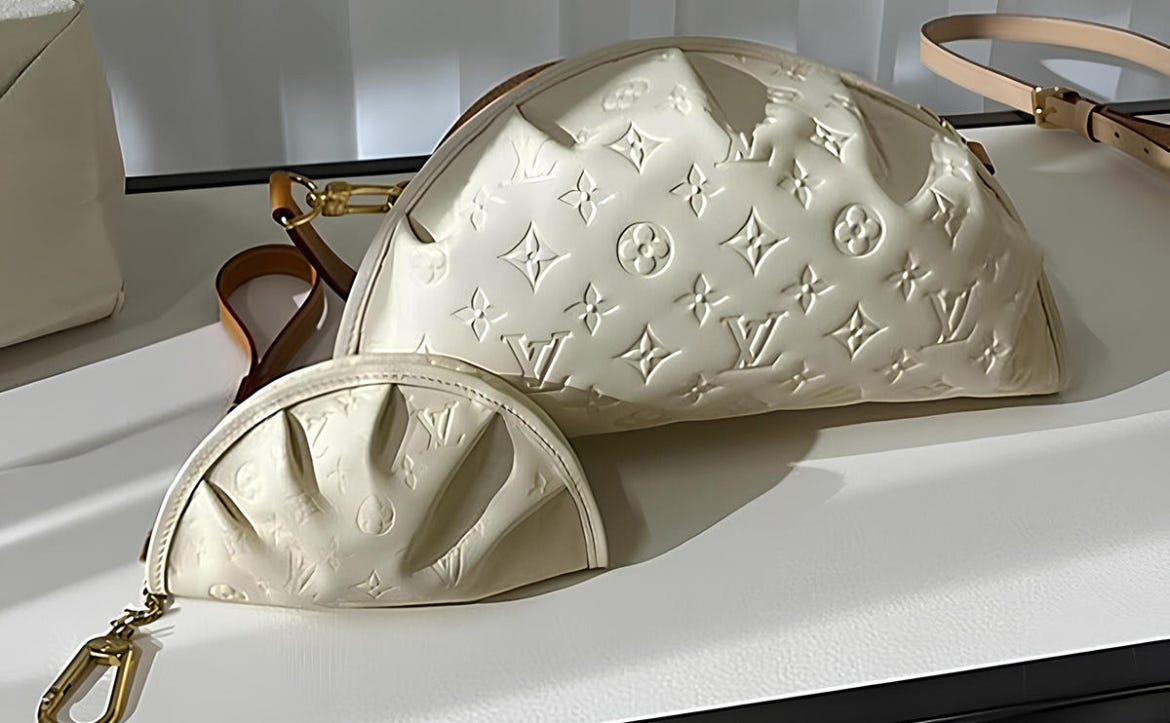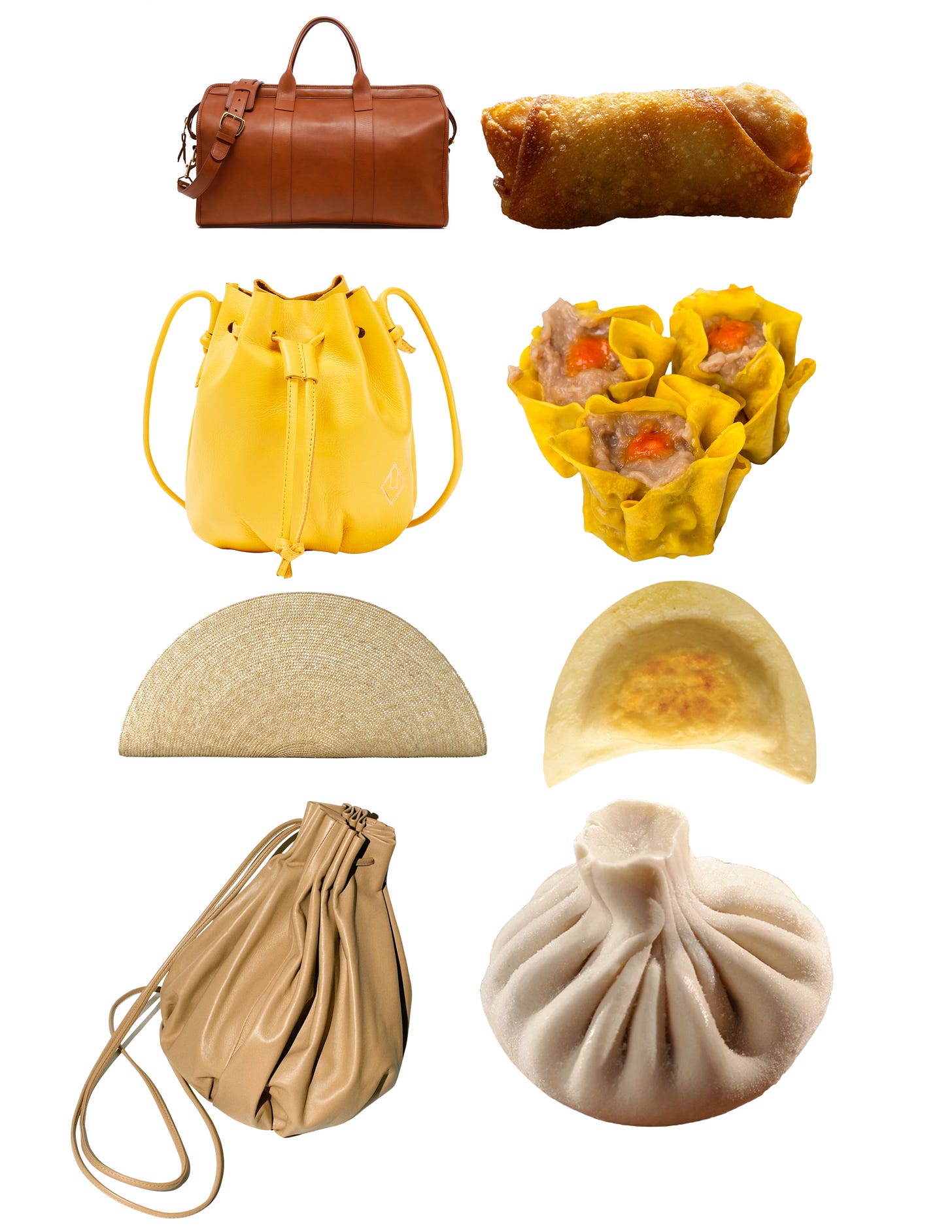This newsletter hasn’t been as active lately, for a couple of reasons. One is that I’ve been spending the last year-plus on Issue 2, which will be live imminently (aka, as soon as I get copies back from the printer!). (Psst: Scroll to the end for a preview!)
Two is that I’m getting married in a week. Turns out, this whole “planning a wedding” thing is “a lot of work.” But I’m writing this newsletter one week out because sure, I could do things like “finish my vows” and “make sure everyone knows where they will be sitting,” but also—I could go down a rabbit hole of exploration around why there are purses that look like dumplings, but also dumplings that look like purses.
If you’re reading this, then you know which impulse won out in the short term. (I believe they call this “procrastination.”).
Investigating the relationship between dumpling-inspired bags + bag-inspired dumplings
A few months ago, I learned about a capsule collection coming from Louis Vuitton’s forthcoming Fall/Winter 2025 collection: A clutch and a coin purse, beige in color with pleated edges, called the Gyoza. Creative director Pharrell Williams allegedly dreamed up the bag in collaboration with Nigo, the creative director of Japanese fashion label Kenzo.
Then, not long after, I saw a video from another FW 2025 preview: Fendi wallets and bag charms designed to look, respectively, like a golden-hued ravioli and a pleated jiaozi.
Food as fodder for luxury handbags isn’t brand-new (see: Leila Gohar’s leather envelopes hand-painted with heirloom beans, this clutch, from JW Anderson, molded to look like a fat slice of Victoria sponge, this fuzzy fanny pack from Fendi that’s shaped like a baguette—itself a semantic nod to the brand’s famous Baguette bag—and Simone Rocha’s hard-sided pearl-hued bag in the shape of another increasingly luxury product: the egg).
So perhaps it makes sense that the trend has come for dumplings, a foodstuff with even more conceptual overlap with bags: There’s an outer layer, one that’s deliberately designed to contain precious cargo inside. In the case of a dumpling, that’s dough and flavorful fillings (pork and cabbage! potatoes and cheese! plums! shrimp! the list is endless). In the case of a bag, that’s some sort of fabric or leather, with such fillings as wallets, lipstick, keys, sunglasses, hand sanitizer, and snacks.
In that vein, what is a duffel bag if not an egg roll? A bucket bag if not a shumai? A half-moon clutch if not a pierogi? You really mean to tell me that Modern Weaving’s pleated leather balloon bag really isn’t a giant khinkali you can tote your belongings around in?
In fact, there are dumplings whose shape and name directly reference purses. Crispy fried Thai thoong tong translates to “moneybags,” named for their golden hue and pouch-like pinched top. Potli samosas, which are shaped similarly, are directly named for “potli,” a Hindi word for “parcel,” also used to describe a style of small pouch-like evening bag. There’s the stuffed Italian pasta sacchetti, which translates to “beggar’s purse.”

Given the currency-specific semantic origins of these dumplings, it’s interesting to see these refracted back in the luxury market. A Louis Vuitton clutch is, in essence, a literal moneybag—while prices haven’t been released yet for the Gyoza collection, comparably-sized bags on LV’s website retail between $1,600 and $5,500. Fendi’s other similar food-inspired bag charms retail between $620 and $1,450. (Something that’s priceless, however: Good pleating skills. After the photos of the gyoza bag began to circulate on Reddit, so too did the criticisms: “My grandma folds better gyoza than LV,” one commenter wrote.)
What, in this day and age, gets to be considered luxury—and commands prices to match? I’ll leave you with a marketing idea for when Louis Vuitton goes to promote the gyoza bags come fall: Why not pair the launch with a pop-up that also sells real, fairly priced gyoza crafted by highly skilled makers who are increasingly stretched by skyrocketing food and labor costs and working to change perceptions around the value of their food?
Just some food (and bags) for thought.
A treat for those who read to the end: Soft-launching Above the Fold Issue 2 (!!!)
Issue 2 shines a light on dumplings unique to the United States, and, more specifically, the incredibly diverse and passionate makers devoted to keeping their traditions alive during increasingly challenging conditions.
This issue is packed with nearly double the contents, and 50% more pages than Issue 1, including:
Personal narratives around Massachusetts’ unexpected relationship with crab rangoons, American-Chinese dim sum experimentation in San Francisco, and how one maker’s empanadas double as a thesis on what it means to make South American food in America.
Tracing the century-long history of the American-Chinese egg roll, invented in New York—and the many innovations it’s since spawned.
A detailed examination at what it takes to operate a domestic dumpling business—from startup costs and pricing to shipping headaches, labor, customer expectations, and more
A multi-spread package exploring the dumplings unique to regions of the U.S., including Filipino-influenced pepperoni bread in Virginia Beach, Pastelitos in Miami, Peking Ravioli in Boston, Toasted Ravioli in St. Louis, Mincemeat Empanaditas in New Mexico, Osage Meat Pies in Oklahoma, and much more
A guide to the best dumplings in Queens, the dumpling capital of America
Recipes for homemade Chef Boyardee-style ravioli, as well as cheeseburger potstickers
Above the Fold was created by Leah Mennies








